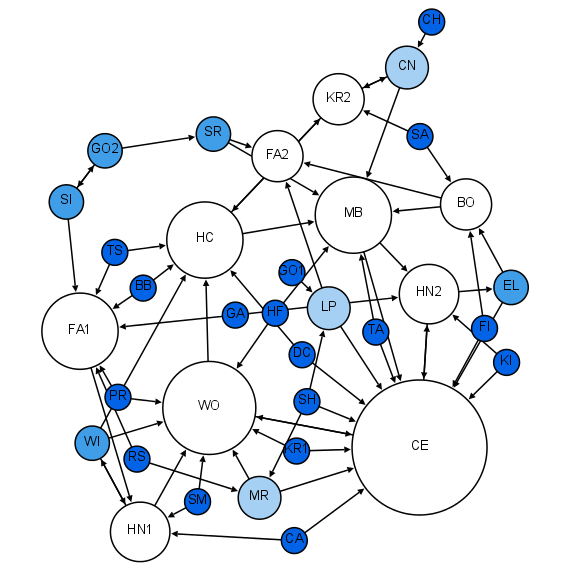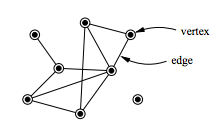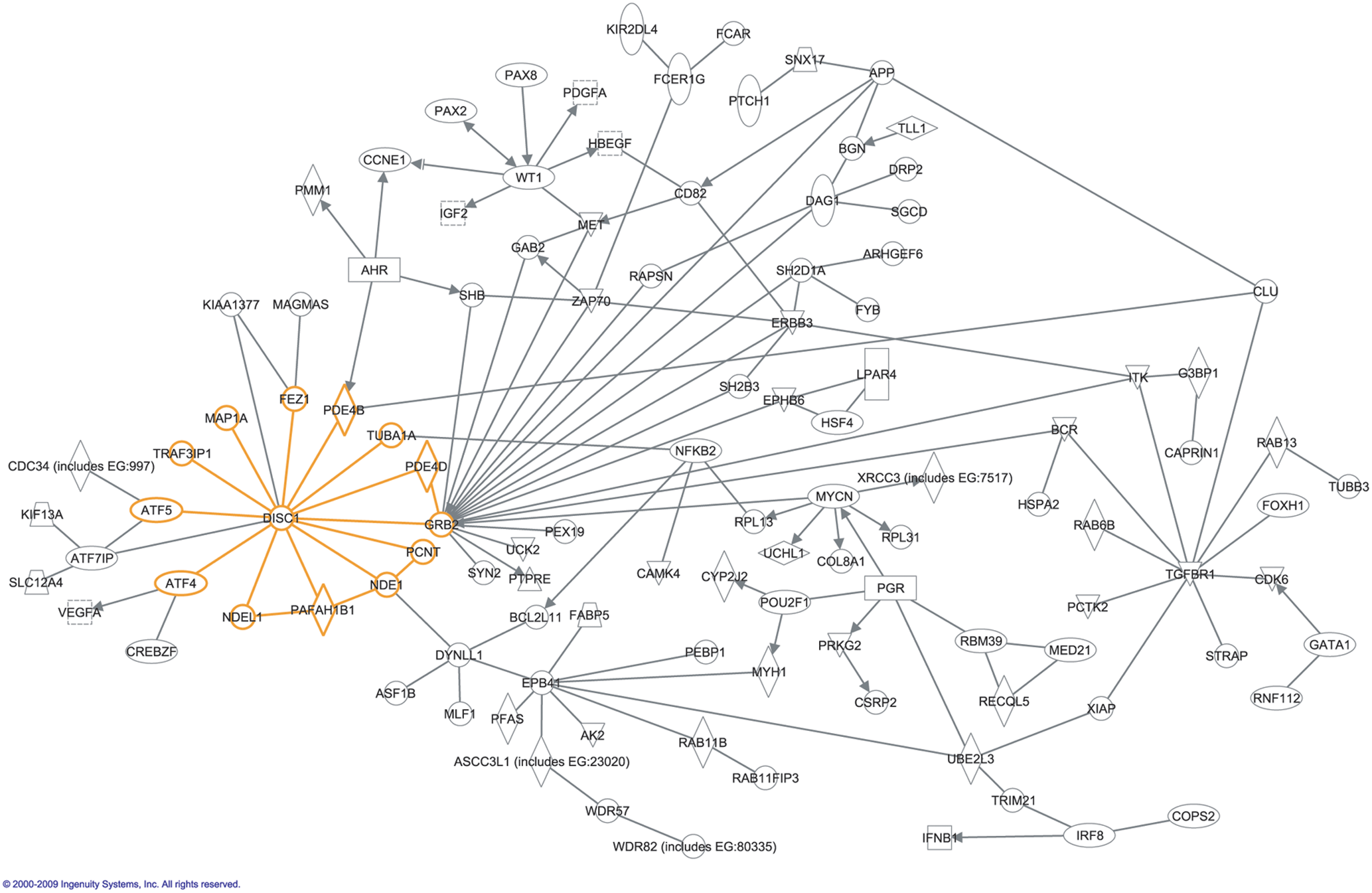|
Network Medicine
Network medicine is the application of network science towards identifying, preventing, and treating diseases. This field focuses on using network topology and network dynamics towards identifying diseases and developing medical drugs. Biological networks, such as protein-protein interactions and metabolic pathways, are utilized by network medicine. human disease network, Disease networks, which map relationships between diseases and biological factors, also play an important role in the field. Epidemiology is extensively studied using network science as well; social networks and flow network, transportation networks are used to model the spreading of disease across populations. Network medicine is a medically focused area of systems biology. Background The term "network medicine" was introduced by Albert-László Barabási in an the article "Network Medicine – From Obesity to the 'Diseasome, published in ''The New England Journal of Medicine'', in 2007. Barabási states that ... [...More Info...] [...Related Items...] OR: [Wikipedia] [Google] [Baidu] |
Network Science
Network science is an academic field which studies complex networks such as telecommunication networks, computer networks, biological networks, Cognitive network, cognitive and semantic networks, and social networks, considering distinct elements or actors represented by ''nodes'' (or ''vertices'') and the connections between the elements or actors as ''links'' (or ''edges''). The field draws on theories and methods including graph theory from mathematics, statistical mechanics from physics, data mining and information visualization from computer science, inferential statistics, inferential modeling from statistics, and social structure from sociology. The United States National Research Council defines network science as "the study of network representations of physical, biological, and social phenomena leading to predictive models of these phenomena." Background and history The study of networks has emerged in diverse disciplines as a means of analyzing complex relational ... [...More Info...] [...Related Items...] OR: [Wikipedia] [Google] [Baidu] |
Biomolecule
A biomolecule or biological molecule is loosely defined as a molecule produced by a living organism and essential to one or more typically biological processes. Biomolecules include large macromolecules such as proteins, carbohydrates, lipids, and nucleic acids, as well as small molecules such as vitamins and hormones. A general name for this class of material is ''biological materials''. Biomolecules are an important element of living organisms. They are often endogeny (biology), endogenous, i.e. produced within the organism, but organisms usually also need exogeny, exogenous biomolecules, for example certain nutrients, to survive. Biomolecules and their organic reaction, reactions are studied in biology and its subfields of biochemistry and molecular biology. Most biomolecules are organic compounds, and just four chemical element, elements—oxygen, carbon, hydrogen, and nitrogen—make up 96% of the human body's mass. But many other elements, such as the various biometal (b ... [...More Info...] [...Related Items...] OR: [Wikipedia] [Google] [Baidu] |
Node (graph Theory)
In discrete mathematics, and more specifically in graph theory, a vertex (plural vertices) or node is the fundamental unit of which graphs are formed: an undirected graph consists of a set of vertices and a set of edges (unordered pairs of vertices), while a directed graph consists of a set of vertices and a set of arcs (ordered pairs of vertices). In a diagram of a graph, a vertex is usually represented by a circle with a label, and an edge is represented by a line or arrow extending from one vertex to another. From the point of view of graph theory, vertices are treated as featureless and indivisible objects, although they may have additional structure depending on the application from which the graph arises; for instance, a semantic network is a graph in which the vertices represent concepts or classes of objects. The two vertices forming an edge are said to be the endpoints of this edge, and the edge is said to be incident to the vertices. A vertex ''w'' is said to be a ... [...More Info...] [...Related Items...] OR: [Wikipedia] [Google] [Baidu] |
Betweenness Centrality
In graph theory, betweenness centrality is a measure of centrality in a graph based on shortest paths. For every pair of vertices in a connected graph, there exists at least one shortest path between the vertices, that is, there exists at least one path such that either the number of edges that the path passes through (for unweighted graphs) or the sum of the weights of the edges (for weighted graphs) is minimized. Betweenness centrality was devised as a general measure of centrality: it applies to a wide range of problems in network theory, including problems related to social networks, biology, transport and scientific cooperation. Although earlier authors have intuitively described centrality as based on betweenness, gave the first formal definition of betweenness centrality. Betweenness centrality finds wide application in network theory; it represents the degree to which nodes stand between each other. For example, in a telecommunications network, a node with higher b ... [...More Info...] [...Related Items...] OR: [Wikipedia] [Google] [Baidu] |
Small-world Network
A small-world network is a graph characterized by a high clustering coefficient and low distances. In an example of the social network, high clustering implies the high probability that two friends of one person are friends themselves. The low distances, on the other hand, mean that there is a short chain of social connections between any two people (this effect is known as six degrees of separation). Specifically, a small-world network is defined to be a network where the typical distance ''L'' between two randomly chosen nodes (the number of steps required) grows proportionally to the logarithm of the number of nodes ''N'' in the network, that is: :L \propto \log N while the global clustering coefficient is not small. In the context of a social network, this results in the small world phenomenon of strangers being linked by a short chain of acquaintances. Many empirical graphs show the small-world effect, including social networks, wikis such as Wikipedia, gene n ... [...More Info...] [...Related Items...] OR: [Wikipedia] [Google] [Baidu] |
Assortativity
Assortativity, or assortative mixing, is a preference for a network's nodes to attach to others that are similar in some way. Though the specific measure of similarity may vary, network theorists often examine assortativity in terms of a node's degree. The addition of this characteristic to network models more closely approximates the behaviors of many real world networks. Correlations between nodes of similar degree are often found in the mixing patterns of many observable networks. For instance, in social networks, nodes tend to be connected with other nodes with similar degree values. This tendency is referred to as assortative mixing, or ''assortativity''. On the other hand, technological and biological networks typically show disassortative mixing, or ''disassortativity'', as high degree nodes tend to attach to low degree nodes. Measurement Assortativity is often operationalized as a correlation between two nodes. However, there are several ways to capture such a corr ... [...More Info...] [...Related Items...] OR: [Wikipedia] [Google] [Baidu] |
Scale-free Network
A scale-free network is a network whose degree distribution follows a power law, at least asymptotically. That is, the fraction ''P''(''k'') of nodes in the network having ''k'' connections to other nodes goes for large values of ''k'' as : P(k) \ \sim \ k^\boldsymbol where \gamma is a parameter whose value is typically in the range 2<\gamma<3 (wherein the second moment ( scale parameter) of is infinite but the first moment is finite), although occasionally it may lie outside these bounds. The name "scale-free" could be explained by the fact that some moments of the degree distribution are not defined, so that the network does not have a characteristic scale or "size". and the [...More Info...] [...Related Items...] OR: [Wikipedia] [Google] [Baidu] |
Interactome
In molecular biology, an interactome is the whole set of molecular interactions in a particular cell. The term specifically refers to physical interactions among molecules (such as those among proteins, also known as protein–protein interactions, PPIs; or between small molecules and proteins) but can also describe sets of indirect interactions among genes ( genetic interactions). The word "interactome" was originally coined in 1999 by a group of French scientists headed by Bernard Jacq. Mathematically, interactomes are generally displayed as graphs. While interactomes may be described as biological networks, they should not be confused with other networks such as neural networks or food webs. Molecular interaction networks Molecular interactions can occur between molecules belonging to different biochemical families (proteins, nucleic acids, lipids, carbohydrates, etc.) and also within a given family. Whenever such molecules are connected by physical interactions, they form m ... [...More Info...] [...Related Items...] OR: [Wikipedia] [Google] [Baidu] |
OMIM
Online Mendelian Inheritance in Man (OMIM) is a continuously updated catalog of human genes and genetic disorders and traits, with a particular focus on the gene-phenotype relationship. , approximately 9,000 of the over 25,000 entries in OMIM represented phenotypes; the rest represented genes, many of which were related to known phenotypes. Versions and history OMIM is the online continuation of Victor A. McKusick's ''Mendelian Inheritance in Man'' (MIM), which was published in 12 editions between 1966 and 1998.McKusick, V. A. ''Mendelian Inheritance in Man. Catalogs of Autosomal Dominant, Autosomal Recessive and X-Linked Phenotypes.'' Baltimore, MD: Johns Hopkins University Press, 1st ed, 1996; 2nd ed, 1969; 3rd ed, 1971; 4th ed, 1975; 5th ed, 1978; 6th ed, 1983; 7th ed, 1986; 8th ed, 1988; 9th ed, 1990; 10th ed, 1992. Nearly all of the 1,486 entries in the first edition of MIM discussed phenotypes. MIM/OMIM is produced and curated at the Johns Hopkins School of Medicine ( ... [...More Info...] [...Related Items...] OR: [Wikipedia] [Google] [Baidu] |
Gene
In biology, the word gene has two meanings. The Mendelian gene is a basic unit of heredity. The molecular gene is a sequence of nucleotides in DNA that is transcribed to produce a functional RNA. There are two types of molecular genes: protein-coding genes and non-coding genes. During gene expression (the synthesis of Gene product, RNA or protein from a gene), DNA is first transcription (biology), copied into RNA. RNA can be non-coding RNA, directly functional or be the intermediate protein biosynthesis, template for the synthesis of a protein. The transmission of genes to an organism's offspring, is the basis of the inheritance of phenotypic traits from one generation to the next. These genes make up different DNA sequences, together called a genotype, that is specific to every given individual, within the gene pool of the population (biology), population of a given species. The genotype, along with environmental and developmental factors, ultimately determines the phenotype ... [...More Info...] [...Related Items...] OR: [Wikipedia] [Google] [Baidu] |
Bipartite Graph
In the mathematics, mathematical field of graph theory, a bipartite graph (or bigraph) is a Graph (discrete mathematics), graph whose vertex (graph theory), vertices can be divided into two disjoint sets, disjoint and Independent set (graph theory), independent sets U and V, that is, every edge (graph theory), edge connects a Vertex (graph theory), vertex in U to one in V. Vertex sets U and V are usually called the ''parts'' of the graph. Equivalently, a bipartite graph is a graph that does not contain any odd-length cycle (graph theory), cycles. The two sets U and V may be thought of as a graph coloring, coloring of the graph with two colors: if one colors all nodes in U blue, and all nodes in V red, each edge has endpoints of differing colors, as is required in the graph coloring problem.. In contrast, such a coloring is impossible in the case of a non-bipartite graph, such as a Gallery of named graphs, triangle: after one node is colored blue and another red, the third vertex ... [...More Info...] [...Related Items...] OR: [Wikipedia] [Google] [Baidu] |



